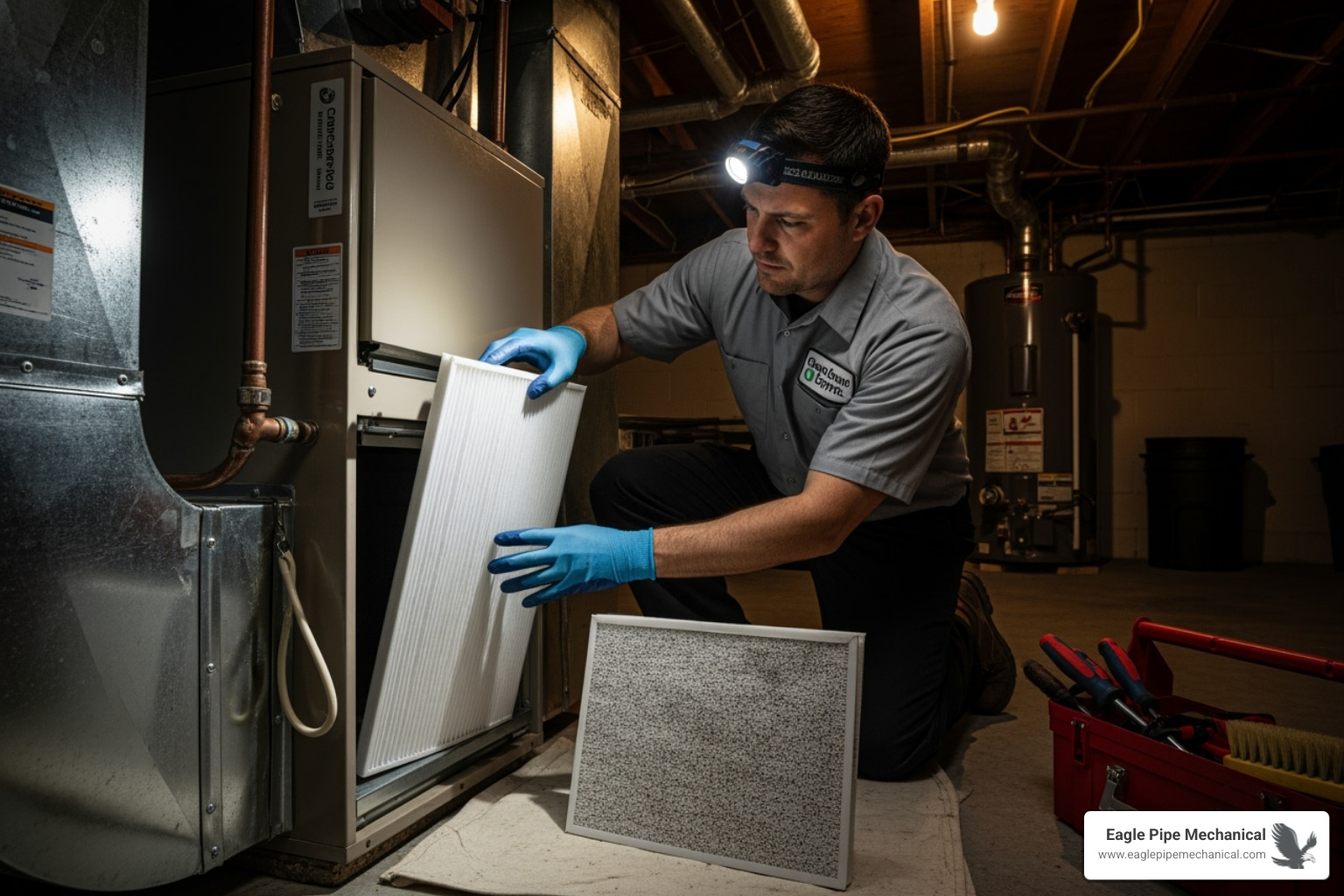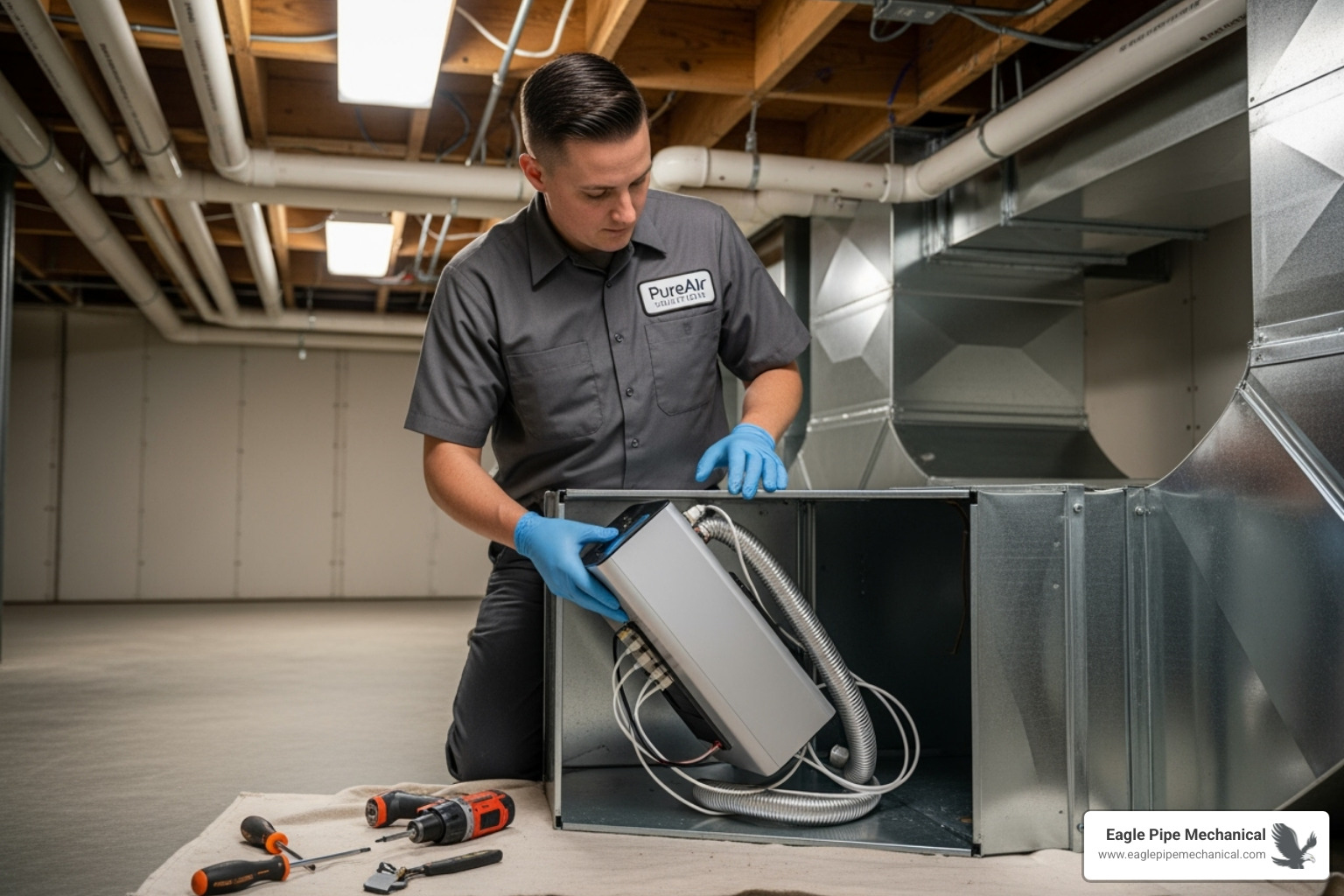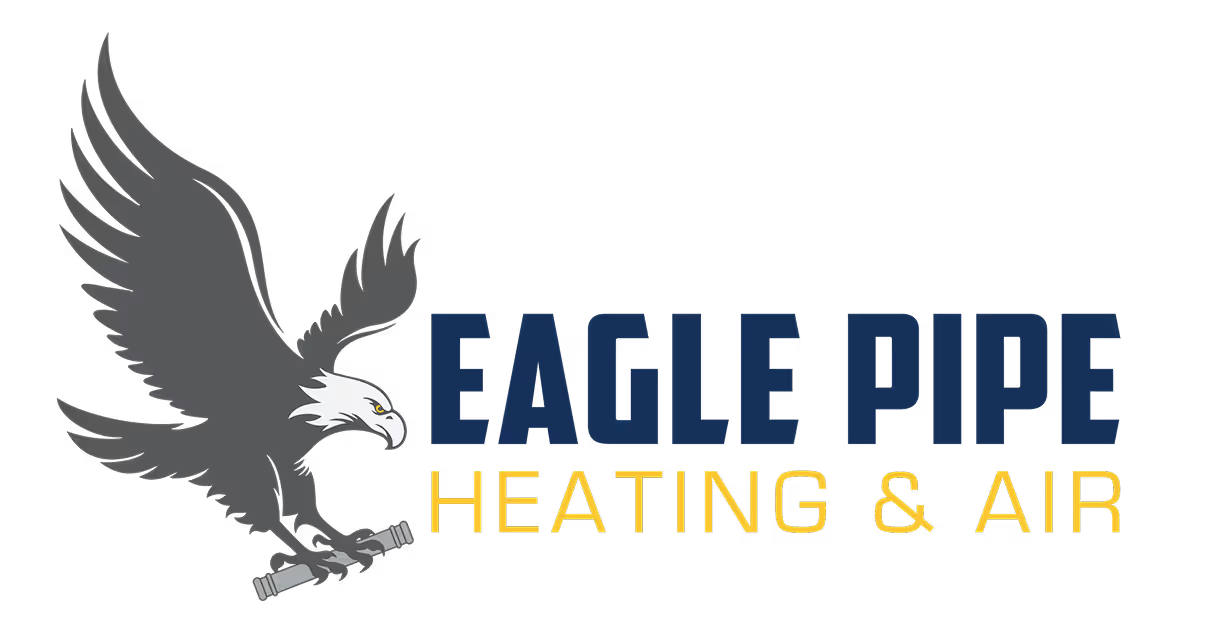Beyond the Haze: Unlocking the Secrets to Superior Air Quality

Why Air Quality Improvement Matters More Than You Think
Air quality improvement is essential for your health and comfort, since Americans spend 90% of their time indoors. Here's what you need to know:
Key Air Quality Improvement Strategies:
- Source Control - Remove or reduce pollution sources (most effective and cost-efficient)
- Improve Ventilation - Increase outdoor air circulation through windows, fans, or HVAC systems
- Air Cleaning - Use HEPA filters and air purifiers to remove particles and allergens
- Regular Maintenance - Change HVAC filters every 1-3 months with MERV-13 rated filters
- Control Humidity - Keep levels between 30-50% to prevent mold and dust mites
Most homeowners don't realize that indoor air can be two to five times more polluted than outdoor air. This is especially concerning in the Pacific Northwest, where we seal our homes tight against the weather.
The health impacts are serious. Poor indoor air quality contributes to respiratory problems, aggravated asthma, and can affect your sleep and productivity. Radon exposure alone is the second leading cause of lung cancer in the United States.
The good news? Small changes make a big difference. Simple steps like opening windows daily, using exhaust fans, and keeping your home smoke-free can dramatically improve your indoor environment.
Understanding the sources of indoor pollution is the first step toward cleaner, healthier air.

Understanding the Invisible Threat: Pollutants and Their Health Effects
The biggest challenge with air quality improvement is that most threats are invisible. You can't see the microscopic particles or smell the odorless gases that might be seeping into your basement. Yet these pollutants can seriously impact your health.
Let's start with one of the most dangerous culprits: Particulate Matter (PM2.5). These particles are incredibly tiny—about 30 times smaller than a human hair. Because they're so small, they bypass your body's defenses and travel deep into your alveoli (the tiny air sacs in your lungs). The smallest particles can even enter your bloodstream directly.
Roughly one in three Americans is at higher risk for PM2.5-related health problems. Particle pollution causes thousands of premature deaths annually. It contributes to aggravated asthma, chronic bronchitis, reduced lung function, irregular heartbeats, and heart attacks.
Volatile Organic Compounds (VOCs) are another major concern. These gases come from everyday items like cleaning products, paints, carpets, furniture, and air fresheners. Breathing in VOCs can irritate your eyes, nose, and throat, cause nausea, and damage your central nervous system. Some VOCs are known to cause cancer.
Then there's radon—the silent killer. This naturally occurring radioactive gas is odorless, colorless, and tasteless. It seeps from the ground and can accumulate in basements and lower levels. Radon exposure is the second leading cause of lung cancer in the United States, which makes testing your home absolutely critical.
Ground-level ozone rounds out our list of major outdoor pollutants. It forms when pollutants from cars, factories, and chemical solvents react in sunlight. It causes respiratory irritation and can worsen asthma and other breathing problems.
Health effects range from headaches and throat irritation to serious long-term problems like cardiovascular disease, central nervous system damage, and various cancers. Even your car isn't safe—scientific research on in-car pollution shows that exhaust from nearby vehicles can increase pollution levels inside your vehicle.
Common Indoor Air Pollutants
Your home can harbor many air quality threats, many from everyday activities and products.
Household dust is a mix of dead skin cells, dust mite droppings, and body fragments. Pet dander—those tiny flakes of skin our furry friends shed—is one of the most common indoor allergens.
Mold thrives in damp environments like bathrooms and basements. Its airborne spores can trigger allergies and respiratory problems. Tobacco smoke contains thousands of harmful chemicals, many carcinogenic, that cling to fabrics and surfaces.
Combustion appliances like furnaces, gas stoves, and fireplaces can release carbon monoxide, nitrogen dioxide, and particulate matter if not properly vented or maintained. This is a significant concern for the two-thirds of U.S. households that burn fuel.
Many cleaning products contain irritating VOCs. Paints and glues off-gas VOCs, especially when new. Building materials and new furniture can release formaldehyde and other chemicals.
And don't forget about radon gas—the invisible threat that can seep into your home from the ground.
Key Outdoor Air Pollutants
Outdoor air pollution directly affects indoor air, so understanding its sources is crucial for air quality improvement.
Motor vehicle exhaust is a common pollutant you encounter. Cars, trucks, and buses release nitrogen oxides, carbon monoxide, and particulate matter, especially in heavy traffic. Industrial emissions from factories and power plants add sulfur dioxide, heavy metals, and other harmful substances to the air.
In the Pacific Northwest, wildfire smoke is an increasingly serious concern. These fires produce fine particulate matter and harmful gases that travel hundreds of miles. Gasoline vapors and chemical solvents contribute to ground-level ozone, while particle pollution comes from construction, agriculture, and industry.
Stay informed about outdoor conditions. Check air quality days regularly, especially during wildfire season, so you know when to keep windows closed and limit outdoor activities. This habit can significantly protect your indoor air quality.
A Practical Guide to Indoor Air Quality Improvement
Ready to take control of your home's air? Air quality improvement doesn't have to be overwhelming or expensive. The EPA recommends a three-pronged approach we've seen work in Kitsap and Jefferson Counties: source control, improved ventilation, and air cleaning.
Source control is like fixing a leaky faucet instead of just mopping up water. It's often the most cost-effective approach, stopping the problem at its root. This could mean sealing cracks where radon enters, fixing moisture problems causing mold, or switching to low-VOC cleaning products.
Improved ventilation is your second line of defense. Fresh outdoor air helps dilute indoor pollutants.
Finally, air cleaning and filtration systems capture pollutants already in your home. Combining all three strategies is the most effective and economical approach.
You can start small and build up. Even simple changes can make a noticeable difference.

Key Strategies for Indoor Air Quality Improvement
Here are the most effective steps you can take to breathe easier at home:
Change your HVAC filters regularly - this is one of the easiest, most impactful things you can do. Look for filters with a MERV-13 rating and swap them out every 1-3 months. These filters trap more particles like pollen, pet dander, and dust than basic ones. Bonus: you could save up to 15% on energy bills since your system won't work as hard.
Open windows strategically - even 10 minutes of fresh air daily can work wonders. But check those air quality days first, especially during wildfire season or near busy roads.
Use exhaust fans religiously - run your kitchen fan while cooking and your bathroom fan during showers. These fans pull moisture and pollutants right out of your home.
Test for radon - Radon is the second leading cause of lung cancer, and you can't see, smell, or taste it. You can order a low-cost radon test kit and get peace of mind.
Keep your home smoke-free - tobacco smoke contains thousands of harmful chemicals that stick around. This includes e-cigarettes too.
Choose cleaner candles - If you love candles, choose beeswax or soy versions over paraffin. They burn cleaner and release fewer pollutants.
Control humidity levels - Keep humidity between 30-50% to prevent mold and dust mites.
Clean floors and surfaces regularly - Vacuum with a HEPA filter and dust with microfiber cloths to trap particles.
Switch to natural cleaning products - Vinegar, baking soda, and lemon juice clean well without the harmful VOCs in many chemical cleaners.
Be smart about burning indoors - Older wood stoves can produce 15 to 30 grams of smoke per hour, while new EPA-certified models only produce 2 to 5 grams. Ensure any fireplace or wood stove is properly vented and maintained.
Want more detailed guidance? Check out Learn more about clean air at home for additional tips and resources.
Enhancing Home Ventilation
Good ventilation lets your house breathe. Natural ventilation—simply opening windows and doors—works great when outdoor air quality is good and the weather cooperates. Even brief fresh air circulation makes a huge difference.
Most standard HVAC systems just recirculate indoor air; they don't bring in fresh outdoor air. That's where mechanical ventilation comes in handy.
Your bathroom and kitchen exhaust fans are perfect examples of mechanical ventilation. They pull moisture, fumes, and pollutants outside before they spread. For more comprehensive fresh air, some homes benefit from whole-house ventilation systems like energy-efficient heat recovery ventilators.
If you're renting, a DIY solution is to use an air purifier with tubing and a window adapter to draw in and filter outdoor air. This creates positive pressure, helping keep outdoor pollutants from entering through cracks.
Timing is key. Always check local air quality before opening your home to avoid letting in wildfire smoke or traffic pollution. The Energy Saver: Whole-House Ventilation guide has more details if you're considering a ventilation upgrade.

Using Air Cleaners and Filtration
When source control and ventilation aren't enough, use air cleaners and filtration systems. Think of them as a cleanup crew, removing pollutants from the air.
HEPA filters are the gold standard. These High-Efficiency Particulate Air filters effectively trap allergens, dust, pet dander, mold spores, and tiny PM2.5 particles. You'll find HEPA technology in portable air purifiers and some whole-home HVAC systems.
Your central furnace filter is a key component. We recommend MERV-13 rated filters if your system can handle them. These offer superior filtration over basic fiberglass filters. Unsure what your system can handle? We can help determine the best MERV rating for your setup.
Effective air cleaners must collect pollutants efficiently and process enough air for the room size. A small purifier in a large room is ineffective, as is a great filter with poor airflow.
Important limitation: the EPA doesn't recommend air cleaners for radon reduction due to uncertain effectiveness. For radon, you need source control, like sealing entry points and installing mitigation systems.
Regular maintenance is crucial. Clean or replace filters per manufacturer recommendations for peak performance.

Expanding Our Impact: Community and Outdoor Air Quality
While home air quality is important, real air quality improvement requires community-wide effort. The air doesn't stop at your property line. Your neighbors, local businesses, and local government all affect the air you breathe.
Local governments in Kitsap and Jefferson Counties have a big opportunity. They can create programs that encourage cleaner choices. It's not just about rules and regulations; it's about creating systems that help people choose cleaner options.
One of the biggest game-changers is public transportation. Public transit produces 95% less carbon monoxide than private cars. It also creates over 92% fewer volatile organic compounds and nearly half the carbon dioxide and nitrogen oxide per person. That's a huge difference across thousands of commuters.
Neighborhood connectivity also plays a huge role. When communities are designed for walking, biking, and easy transit access, people drive less. Well-planned neighborhoods with sidewalks, bike lanes, and mixed-use areas naturally reduce vehicle miles traveled.
Local governments can also offer financial incentives for businesses to encourage cleaner practices. This could include rebates for promoting public transit, upgrading to cleaner equipment, or tax breaks for green building improvements.

Community-Level Air Quality Improvement Initiatives
Communities nationwide have found creative ways to tackle air pollution. Here are some programs that work:
Woodstove changeout programs have been incredibly successful. Older wood stoves can produce 15 to 30 grams of smoke per hour, while new EPA-certified models only produce 2 to 5 grams. Many counties offer financial help to replace old stoves with cleaner models.
Commuter benefit programs make it easier and cheaper for people to ditch their cars. This can include subsidized bus passes, carpool assistance, or flexible work schedules to avoid rush hour.
Air awareness campaigns help people understand what they're breathing and what they can do. These work best when businesses, schools, and media help spread the word.
Diesel engine retrofits target some of the dirtiest engines. Diesel engines in construction and farm equipment contribute nearly 45% of mobile source diesel particulate matter nationwide. Upgrading these engines with better emissions controls greatly improves local air quality.
Lawn mower exchanges offer rebates for electric alternatives to surprisingly dirty gas-powered mowers.
Anti-idling campaigns encourage drivers to turn off their engines when parked, which is especially important around schools.
The Role of Regulations and Goal Setting
Behind these local efforts, a larger system of laws and standards guides national air quality improvement. This framework ensures everyone works toward the same goals.
The Clean Air Act is the foundation. This law authorizes the EPA to set and enforce national air quality standards. EPA regulations turn these goals into specific rules for states and businesses.
National Ambient Air Quality Standards (NAAQS) set limits for six major pollutants: ground-level ozone, particulate matter, carbon monoxide, sulfur dioxide, nitrogen dioxide, and lead. Areas that fail to meet these standards are labeled nonattainment areas, triggering special cleanup requirements.
Hazardous Air Pollutants (HAP) programs focus on pollutants that cause cancer or other serious health problems. State Implementation Plans (SIPs) allow each state to devise its own strategy for meeting federal standards.
This system evolves as we learn more about pollution and health. It provides a framework for communities like Kitsap and Jefferson Counties to address local challenges within proven guidelines. The key is that all these efforts—from individual actions to federal regulations—work together. When we improve air quality at every level, we all breathe easier.
Frequently Asked Questions about Air Quality
As HVAC professionals in Kitsap and Jefferson Counties, we get many questions about air quality improvement. Here are answers to the most common ones.
How can I test the air quality in my home?
Testing your home's air quality is simpler than you might think and a smart first step. We highly recommend testing for radon, the second leading cause of lung cancer, which is invisible and odorless.
You can order an easy-to-use, low-cost radon test kit. Place it in your lowest lived-in level for a few days, then mail it to a lab for results.
For other pollutants like volatile organic compounds (VOCs) or mold, professional testing provides the most detailed analysis. For ongoing monitoring, consumer-grade air quality monitors are a good option. They track particulate matter and VOCs in real-time, showing when your air quality improvement efforts are working.
Are houseplants effective for cleaning the air?
Houseplants aren't the air-cleaning heroes many believe them to be. While plants absorb some pollutants, science shows you'd need an unrealistic number to significantly improve air quality—dozens or hundreds in a typical room.
Plants are wonderful for other reasons: they boost your mood, add humidity, and make your space more pleasant. But for serious air quality improvement, rely on proper ventilation, filtration, and source control. Think of plants as a bonus, not your main defense.
What is the most effective single action I can take for my home's air?
There's no single magic bullet for perfect air quality. The most effective approach combines source control, ventilation, and filtration.
But for the biggest impact, we recommend regularly changing your HVAC filter to a high-efficiency MERV-13 model. This simple step impacts your entire home's air, as your HVAC system circulates it throughout the house.
A good filter works 24/7, trapping particles like dust, pollen, and pet dander. Plus, clean filters help your HVAC system run more efficiently, saving you money.
The key is "regularly"—check your filter monthly and change it every 1-3 months, depending on your household. Homes with pets, smokers, or allergies may need more frequent changes.
Air quality improvement is about creating and maintaining healthy habits. Small, regular actions are often better than big, one-time fixes.
Breathe Easier with Expert Solutions
Taking control of your home's air quality improvement isn't overwhelming. With the right knowledge, tools, and occasional professional help, you can create an environment where your family thrives.
Cleaner air comes from understanding invisible threats and taking smart action. Sometimes it's as simple as opening a window. Other times, it means investing in better filtration or calling experts to optimize your system.
What makes the biggest difference? It's the combination approach. Source control tackles root problems. Good ventilation brings in fresh air. Quality filtration catches remaining pollutants. When these three strategies work together, you'll notice the difference.
We've seen it countless times in Kitsap and Jefferson Counties: families who thought "stuffy air" was normal find what truly clean indoor air feels like. The result is better sleep, fewer allergy symptoms, and a fresh feeling inside your home.
At Eagle Pipe Mechanical, we're more than your neighborhood HVAC and plumbing contractor; we're your partners in creating healthier homes. Whether you need a filter upgrade, an air purification system, or help troubleshooting your indoor air, we've got you covered.
Our team understands every home in areas like Poulsbo is unique. A century-old farmhouse has different needs than new construction. We listen first, then recommend solutions for your family and budget. With our maintenance plans and financing options, caring for your air quality is affordable.
Don't wait another season wondering if your family's air could be better. You deserve confidence in your indoor environment. Get professional help with your indoor air quality and find what a difference expert solutions can make.
CUSTOMER TESTIMONIALS
Our customers’ experiences say more than we ever could. See how Eagle Pipe Heating & Air has earned trust across the Pacific Northwest with reliable service and lasting results.





